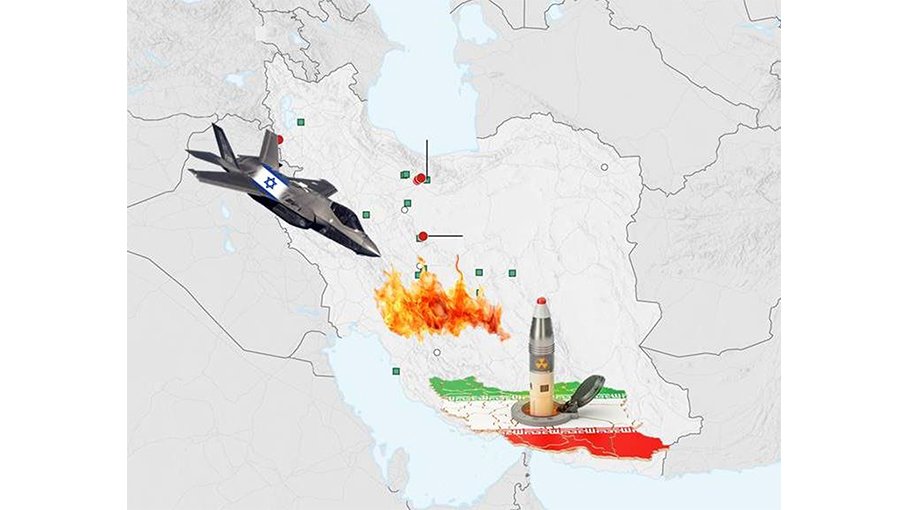Iran-Israel conflict 2025 and likely scenarios

Tasnia Tasnim Hossain
“Two months ago I gave Iran a 60-day ultimatum to ‘make a deal.’ They should have done it! Today is day 61. I told them what to do, but they just couldn’t get there. Now they have, perhaps, a second chance!” Trump said in a post on Truth Social on 13th June 2025, and it happened. On June 13 Israel started “Operation Rising Lion” - targeted airstrikes on Iran’s military and nuclear facilities, deploying 200 fighter jets to strike over 100 targets across the country. Israel, supported by the US demonstrated strategic outreach, deterrence and operational overmatch. Israel hit Iran’s main uranium enrichment facilities in Bushehr, Fordow, Natanz. However, the IAEA confirmed that there was no increase of radiation levels in the areas.
The attacks targeted numerous of Iran’s nuclear scientists and military commanders. It comprised key leadership of Military, Islamic Revolutionary Guard Corps (IRGC), personnel involved in Iran’s nuclear/ scientific development, energy sector, administrative infrastructures, missile launching sites, ports and other installations.
In this operation Israel displayed a stunning capability combination of planning, precision, secrecy and determination. The fearsome Israeli intelligence agency Mossad smuggled hardware into Iran, and established a base for launching explosive laden drones. These were covertly launched on 13th June prior to the main Israeli air strike targeting Iranian missile depots, radar sites, UAV facilities and above all, air defence systems near Tehran. This allowed the Israeli strike aircrafts a relatively safe run and ensure degraded and delayed Iranian response. Similar technique was used by the Ukrainians in their recent strikes against Russian Air Bases – may be the Ukrainians were trained by the Israelis and the Ukrainian operation was a test case for this Israeli Operation in Iran. This is a dangerous precedent that might be mimicked by terrorists, states and Non-state Actors (NSAs) alike, effectively putting another statehood haplessly hostage. Again, the conspiracy theory of Ukraine striking inside Russia was a deliberately planned distraction to keep the Russians domestically preoccupied and temporarily unable to assist its ally Iran from an Israeli strike, may warrant due considerations. Israel vowed for "prolonged operation".
Iran responded with “Operation True promise-3”. The Iranian responses accounted for strikes by drones, ballistic and cruise missiles fired. Iran has already closed the Hormuz Strait and threatened strikes against ships. Iran’s retaliatory missile attacks targeted Israeli Defence Ministry building, Haifa Ports/ oil refineries, military scientific research center and numerous other military, civilian and administrative infrastructures. Iranian Haj Qassem hypersonic ballistic missile first used on 15 June successfully evaded all Israeli/ assisting US air defences. Iranian media claimed downing numerous Israeli aircrafts including two Israeli F35 “Adir” Stealth fighters and capturing a female pilot – facts vehemently denied by Israel. Israel countered Iranian missile attacks with US and likely NATO assistances. Iran has likely following options for continued retaliation:
• Continuation of the ongoing ballistic/cruise missile attack. While a ballistic missile takes 12 minutes to reach target and may be intercepted by Arrow and US (crewed) THAAD systems, a cruise missile takes longer, around 2 hours (making it easier to intercept) further aided by Patriot, Iron Dome and David’s Sling systems. Thus, ballistic missiles remain the preferred option. However, a combination of both, which would over-saturate Israeli air/missile defences possibly remains the best choice.
• Proxy attacks through the Houthis, Hezbollah, Islamic Jihad against Israeli mainland, US and Western forces
in the region.
• Using Iranian/ IRGC Navy to conduct attacks on commercial/ naval ships and vessels using missiles and drones (reminiscent of the ‘80s “Tanker War”) in the Persian Gulf or the Gulf of Oman, which are the world’s most important energy routes. The new domestically developed long range (though yet operationally untested) Anti-Ship Ballistic Missile (ASBM) like the Abu Mahdi (1000 km range), capable of striking far beyond Iran’s shores and into the Indian Ocean may also be used.
• Iran may target Israelis and Westerners in foreign countries like previous in Turkey, Cyprus and Greece, South America, Europe, and Asia. Israel has temporarily shut down its embassies worldwide. Iran may also use conventional military means to target U.S. bases across Middle East using drones and missiles.
• Iran may covertly resort to Pakistani advisory and technical assistances to fend off further Israeli assistances, in light of the recent Pakistani steps corresponding to recent Indo-Pak clash. Iran voiced withdrawal intentions from the NPT treaty, threatened to make nuclear weapons and may even use those if regime survival is stake.
According to experts, firepower alone may not be sufficient to neutralise Iran’s nuclear potential since most of its facilities are buried deep underground – the Taliban top leadership’s miraculous survival even after the devastating Tora Bora bombings by the US amply substantiates the fact. Iran also has sufficient nuclear scientists with the necessary expertise. Despite claims of the underground area destructions of the Natanz facility, satellite imagery shows destruction of the surface areas only – an indication of potential U.S. non-involvement.
The world held mixed reactions to the Israeli attack on Iran. Numerous World leaders including the UN Secretary General called for restraint. The Saudi and Qatari Governments strongly denounced it, accompanied by Turkey. Processions across the world including in the Hague is on. The IAEA Chief Rafael Grossi strongly opposed against striking Iran’s nuclear facilities. The US supported Israeli attacks, but denied involvements. However, President Trump warned Iran to agree to a nuclear deal “before there is nothing left.” He nevertheless, voiced optimism for a Iran-Israel Treaty before proceeding for G-7 meeting in Canada. Ned Price, the spokesperson for the U.S. State Department labeled the strike “premature” and branded such an action closing the window for diplomacy that could have remained open until the negotiations with Iran in September. The UK Premier denied UK assistance to Israel, but supported Israeli rights for selfdefense. British Typhoon Fighters and naval vessels were already sent to Middle East for impending crisis. Iraq filed a complaint with the UN Security Council over Israel’s “violation of Iraqi airspace” in a major attack on Iran. Pakistan stated condemnation and urged Muslim unity. China expressed concerns, while Russia expressed concerns and condemnations. The EU urged for restraints.
Netanyahu is facing charges of corruption at home along with a bill to dissolve his parliament that could collapse his government. Besides, his request for the withdrawal of his warrant to the ICC awaits likely rejection. Israel faces a case in the ICJ on alleged genocide and is yet to free 53 hostages held by Hamas. Amid the attack on Iran is a much-needed distraction. Netanyahu declared forced regime change in Iran, an objective. The son of Iran's late Shah appealed on 13 June to Iranian security forces to rise up for Iranian Regime change and allegedly met Netanyahu in 2023. The potential Netanyahu-Shah’s Son nexus of Iranian regime change success would significantly bolster Netanyahu’s domestic and external clouts.
The conflict may escalate and have long lasting impacts. Oil price is rising. Enough tankers being sunk in the Hormuz Strait or oil refineries set in flames in the Gulf Region would severely impact the global economy. The cycle of events may be: Israel and Iran continue striking each other. The US is forced to help defend Israel; Iran hits Israel, the US and possibly US allies. Iran with its vast missile arsenal may continue attacking Israel for weeks – significantly damaging Israel, for which its population is inexperienced, contrary to decades long lowprofile indigenous rocket attacks from Non State Actors (NSAs) in the Gaza Strip, Lebanon and Yemen. The events may go out of hand, unless the recent Indo-Pak type hasty agreement is reached, and even lead to nuclear escalation far beyond the region. The Gulf Monarchies (UAE, Saudi Arabia, Bahrain) might relax from Iran’s ruin, while forming some kind of future security convergence with Israel. The vaunted Russia–China–Iran “Eurasian triangle” to counterbalance Western power has revealed its limitations in supporting Iran. Iran’s deterrence may gradually erode due to decades of economic sanctions, internal unrest and overextension in proxy conflicts.
A seriously degraded Iran (forced regime changed) may eventually plunge into the abyss of a Syria like situation – an opulent source of economic exploitation.
The weakening of Iran would degrade BRICS+ stance for global economic-strategic alternative, reaffirming the petrodollar’s dominance. This might push global economies further into the Western orbit and reshape global strategic orientation. To reaffirm its domestic and global importance, Chinese CCP led government may hasten its promised actions against Taiwan or the South China Sea (SCS) areas. Russia would lose its drone/ supplementary hardware supply from Iran, creating a new dimension in the RussoUkrainian Conflict. Through conflict escalations, Bangladesh may experience mass expatriate job losses from Middle East, loss of remittances and resultant multifarious domestic disturbances. The world is truly on the brink of mega uncertainty.
Tasnia Tasnim Hossain, is an International Relations (IR) Student at the Bangladesh University of Professionals (BUP) and a multiple award winner of “Model United Nations (MUN)” competition sessions. Email: hossaintasnia08@gmail.com



